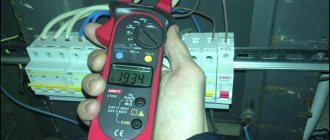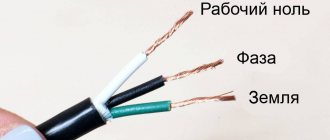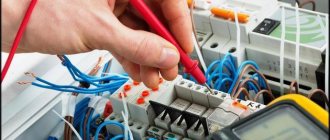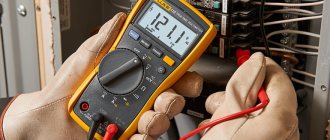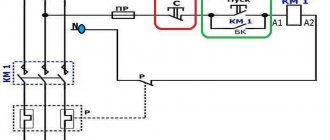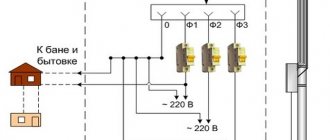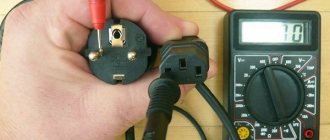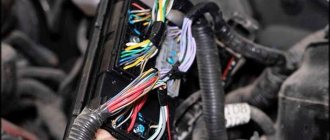Hello friends. Have you ever encountered the phenomenon “ zero burnout"? If not, then you are a happy person. But it will be useful to know about this, especially for electricians. Let's talk about why this mysterious zero tends to burn out, what happens when this happens, and what kind of protection is there against zero burning out? In order to understand this, let's remember a little physics.
I found a good video on the Internet on the topic, short and clear, if you don’t like to read, watch below. So, let's begin.
Zero
, for a single-phase circuit, is the name of the conductor that is not at high potential relative to ground.
Phase
is the second conductor, it has a high alternating voltage potential relative to ground. In Russia, most often, it is 220-230 Volts. Zero does not show a tendency to burn out.
The main catch is that all power lines are three-phase. Consider the traditional star circuit:
This is where the concept of “neutral conductor” appears.
In three identical loads, the alternating current of each phase is 1/3 out of phase. Ideally, these currents cancel each other out. With such a load, at the midpoint, the vector sum of the currents is zero.
It turns out that no current flows through the neutral wire connected to the midpoint (it is practically not needed).
A small current still occurs on the neutral conductor. This happens when the loads on the phases do not fully compensate each other, that is, they are different. Direct proof of this can be seen in practice, look at four-core cables for three-phase circuits, the neutral core has half the cross-section of the phase wires. Why waste scarce copper if there is practically no current in the core? It makes sense...
With a concentrated load, in a three-phase circuit, the zero is also not prone to burning out.
Things get interesting when single-phase loads begin to be connected to a three-phase circuit (in apartment buildings, for example). Each load represents a randomly selected device.
When using one phase from a three-phase circuit, they try to distribute them according to power so that each carries approximately the same load.
Everyone understands that complete equality cannot be achieved. Residents of the house will randomly turn on and off electrical appliances, so the load will constantly change. Full compensation of currents at the midpoint will not occur, but the neutral conductor current usually does not reach a maximum value greater than the current in one of the phases. The situation is predictable; zero burnout is extremely rare.
Where does zero break occur?
It is fundamentally important that a zero break can occur in three-phase or single-phase networks.
Completely different processes take place there; I’ll go into detail below. In short, what happens:
When the zero is broken in a three-phase network, a phase imbalance appears, which can lead to the voltage in the apartment outlet increasing to 380 V! For a person, if grounding is performed correctly, such an accident is not dangerous. But for our electrical appliances, the consequences can be very sad! And also for our home, since a fire may occur.
The location of the zero break may be a floor panel, then only apartments on one landing are in the risk zone. Or maybe it’s the input switchgear of a multi-storey building. For example, this:
The input switchgear (RU) in the basement of a multi-storey building is in poor condition
If the zero in a single-phase network breaks, the consequences are not so sad - the voltage in the outlet will be zero, and electrical appliances simply will not work. However, the entire electrical network (and if the grounding is incorrect, even the housing of electrical appliances!) will be at a potential of 220 V!
To begin with, to create fear -
A little about mechanics
Having dealt with the question of how to properly connect the machine, the question of how to install it remained unexamined. If you are planning a new shield, then most likely the first thing you will have to do is install a DIN rail there.
Each modern circuit breaker has a special clamp for mounting on this very rail. The feed-through contact, which is used for the grounding conductor, has the same fastening. By the way, the latch of such a grounding conductor is not made as a separate plastic element, but as a springy part of the housing. This is very convenient, as there is no risk of losing a small but very important detail.
If it is not possible to find a pass-through element, the grounding connection can also be made by twisting. However, to be sure, you can tin the wires with a soldering iron and put heat-shrink tubing on them as insulation. This is completely justified. Do not forget that phase and neutral conductors still “walk” along the shields. If you don't have heat shrink tubing, you can use insulating tape. This will be no less protection against any surprises.
By the way, it is strictly worth remembering that the connection and even grounding cannot be done in such a way as to twist copper and aluminum wires together. These two metals form a galvanic couple, which leads to their oxidation and disruption of conductivity between them. If it turns out that it is not possible to connect them through a pass-through element or a block with steel contacts, then you can tin each of the wires and carefully solder the connection.
Consequences of a zero break in a three-phase network
I'll tell you stories from my life.
- Electricians were repairing the entrance to the entrance. And during the repair, the working zero was turned off for a few seconds. A very unpleasant thing happened: when people returned home in the evening, they discovered that their TVs, refrigerators, chargers, etc. had burned out. - something that is constantly plugged into our outlets. It's good that there hasn't been a fire yet.
- Came on call, complained - tension was floating. I measure the voltage (everything is turned off) - almost 300 volts. Then, when the incandescent lamp is turned on, the voltage drops to 70V... It turned out that a bolt had burnt out in the floor panel, which received a zero. There was a break in the zero, a phase imbalance, and voltages went wild. I replaced the bolt, restored contact, and the voltage returned to normal.
Scratch bolt. Rusty, periodically does not contact!!! If you change it without turning it off, 100% of the equipment in the entrance will burn out!
An article on how I changed the electrical panel there is here.
- I was called to an advertising and publishing company. According to preliminary estimates, the damage is more than 100 thousand rubles, and all due to poor contact on the zero bus:
Zero burnout from the zero bus
The neutral wire burned off from the second bolt. You can see how it fell off under tension. Before falling off, it ALMOST melted the insulation of the phase wires (vertical, red and white).
The server has not been turned on yet, perhaps the intellectual damage will be greater...
At the site of this tragedy, I installed a three-phase voltage relay Barrier, read the article at the link.
As you can see, such problems occur due to incorrect actions of “electricians” or due to spontaneous breakage (burnout) of the neutral wire in the old housing stock.
In this article I will tell you in detail why this happens and how to deal with it.
Installation Rules
Installation of the simplest terminal to the panel is carried out in a closed or open way. The first option prevents malicious damage to the bus of powerful or important devices, the second method is applicable if there is no risk of damage to the device. Zero blocks with screw connections are fixed to the distribution panel on a DIN rail; additional insulation for grounding is not provided.
The cross-section of neutral and phase conductors is the same. A similar requirement applies to tire parameters: the actual cross-section is considered to be the size of the thinnest sections. When combining a group of ground and neutral conductors, end consumers, after dividing the “PEN” input, are connected to different buses: PE and N.
Formation of single-phase and three-phase networks and zero break
A little theory.
As you know, powerful consumers (in this case, apartment buildings) are powered by a three-phase network, in which there are three phases and zero. I already wrote about this system in detail in an article about the differences between three-phase power supply and single-phase power supply, here is a picture from there:
Voltages in a three-phase system
Let's look at this issue again, only from the other side.
This is what a simplified diagram of the power supply to the floor panel looks like:
Power supply system, without zero break. Three apartments are designated by resistors.
Phase wires L1, L2, L3, on which there is a voltage of 220V in relation to the neutral wire N, are marked in red because they pose a danger. The PE grounding is shown below; its wire is connected in the switchgear at the entrance to the building with the neutral.
For more details, I once again urge you to read my article about grounding systems, link at the beginning.
Design features
Upon closer examination of the design, you will notice that it consists of a conductive core and a base made of plastic, which is designed for installation on a DIN rail.
The photo shows the appearance of the NS:
The current-carrying core contains holes and clamping bolts for fixing the conductors in it, as well as for neat and safe wiring of conductors N inside the switchgear. NS differ from each other in both the installation method (housing) and the number of mounting holes, respectively, in length.
To ensure a high-quality connection, as well as simplify further maintenance, the bus is made of a single conductive element of sufficient size made of electrical copper or brass. With a different number of bolt terminals to which neutral (N) conductors are connected.
A distinction is made between ground buses in a housing and grounding buses without a housing; the externally conductive elements are identical. The neutral bus is made in a housing or an insulator is installed. For the correct functioning of differential protection devices, it is necessary to connect them correctly, and to separate the conductors N from PE in the distribution board. In the case of a metal shield, this can only be done by isolating the neutral conductor from the housing.
What does zero burnout lead to in a three-phase network?
What will change if the neutral wire N breaks BEFORE the junction of the neutral wires at one point? There will be a zero break in a three-phase network:
Zero break in a three-phase network
If you look at the diagram, to the right of the break point the voltage will now not be zero, but “walk” within arbitrary limits.
What happens if the zero is disconnected (accidentally or intentionally)? What voltages will be supplied to consumers instead of 220V? It depends.
The picture in a different form may be easier to understand:
Phase imbalance as a result of zero loss.
Consumers are conventionally shown as resistances R1, R2, R3. The voltages indicated in the previous figure as ~220V are designated as ~0...380V. I'll explain why.
So, what happens if the zero disappears (the cross in the lower right corner)? In an ideal case, when the electrical resistance of all consumers is the same, nothing will change at all. That is, there will be no phase imbalance. This happens when three-phase consumers are turned on, for example, electric motors or powerful air heaters.
But in real life this never happens. There is no one in one apartment, and only the TV is on in standby mode and the phone is charging. And the neighbors on the site did the laundry, turned on the split system and electric kettle. And then - BANG! - the zero burns out.
Phase imbalance begins . And how brutal it is depends on the real situation.
For neighbors who are at home, the kettle will stop heating, the washing machine and splitter will go out, and the voltage will drop to 50...100V. Because the “resistance” of these neighbors is much lower than that of those who are not at home. And so, these people are quietly working at work, and at this time in their empty apartment their TV and Chinese charger are smoking. Because the voltage in the sockets jumped to 300...350V.
These are real facts and figures, this sometimes happens, the condition of electrical panels on staircases is often disastrous. Even when a major renovation is carried out in the house, the panels are not touched, since changing the electrical system is much more difficult than painting the house and installing new windows.
Such a fire should be investigated not by calling psychics (you never know, a poltergeist is playing with matches;)), but by calling an electrician.
Now - about
Why does the neutral wire burn out?
Sookie (416style), flickr.com CC BY
On a windy and rainy evening it is especially pleasant to sit in the apartment, doing nothing and enjoying the warmth and comfort. Unfortunately, this idyll is sometimes unexpectedly interrupted - the light bulbs suddenly become unbearably white, the refrigerator hums and shakes, and the TV shows a black screen, and even with smoke. The voltage in the electrical network has increased sharply! Why does this happen and how to deal with it?
The first thing that comes to mind is an electrician's mistake. But the clamps of the phase and neutral wires are very different from each other in appearance, color of the wires, and method of fastening, and a professional electrician can confuse them only in an unconscious state. A more likely reason for the appearance of 380 volts in an apartment is a break in the neutral wire. In professional jargon, this is called zero burnout.
Why does the zero burn out?
Recently, such situations are happening more and more often. This is due both to the general wear and tear of electrical networks and to the technical solutions used in the mass construction of houses in the 50-70s of the twentieth century. When using a three-phase network, all apartments in the house were divided into three groups, connected to three different phases.
At that time, few could imagine any electrical load in the apartment, except for light bulbs and a couple of low-power electrical appliances. The load in the apartment building was almost completely active, linear and symmetrical. In this case, the currents in the phase wires compensated each other, and the current in the neutral wire was relatively small. This led to an obvious solution - there is no point in wasting a lot of material on such a low-functioning wire. They decided to make the neutral wire thinner than the phase wires.
Modern life has made significant adjustments. It is not uncommon for one apartment to have a couple of light bulbs and a TV, and the next apartment to have electric heated floors, an electric boiler, several air conditioners and a jacuzzi. In addition, almost all modern equipment has switching power supplies, which greatly distort the shape of the current in the network. The load in houses is no longer symmetrical and linear - phase currents are not compensated. Sometimes the current in the neutral wire is even greater than the current in the phase wires. Naturally, the thinner wire overheats and cannot withstand it .
Why does overvoltage occur?
It must be said that when zero breaks, not the whole house is “lucky”. Overvoltage can only occur on one or two phases. The rest were lucky, and this time without quotes. The easiest way to understand this is with the example of a house with three apartments.
Each apartment is powered by its own separate phase A, B or C and a neutral wire N. The voltage between phase and neutral is 220 volts - this is exactly the voltage that is needed in the apartment. The voltage between any two phase wires is 380 volts. This is an integral property of a three-phase AC electrical network. Such voltage is absolutely not required in the apartment, and in a working network it does not reach there.
Let's imagine that in apartment 3 all consumers are turned off - this will allow us to temporarily exclude it from consideration along with phase C that supplies it.
And in such a situation, the neutral wire on the supply line breaks. Obviously, both apartments become connected in series , but between two phase wires. And the voltage between phases is the same 380 volts!
Zero break in a single-phase network
Here the picture will be as follows:
Zero break in a single-phase network
For a load that operates on other phases, nothing will change at all. It’s the same as if you turn off the automatic circuit breakers in your apartment – your neighbors won’t give a damn.
But if a break occurs, for example, in a panel, then the entire apartment, including the broken end of the neutral wire, will be under 220V voltage!
Breakage (burnout) happens because of rusty bolts like those at the top of this photo:
Bad zero. Missing zero in the apartment
I repeat - if the grounding is done correctly, or if there is no grounding at all, this accident is not dangerous in any way. And, of course, you don’t need to touch the wires without waiting for an electrician - all have deadly potential!
Okay, we understand who is to blame. What to do?
A little about mechanics
Having dealt with the question of how to properly connect the machine, the question of how to install it remained unexamined. If you are planning a new shield, then most likely the first thing you will have to do is install a DIN rail there.
Each modern circuit breaker has a special clamp for mounting on this very rail. The feed-through contact, which is used for the grounding conductor, has the same fastening. By the way, the latch of such a grounding conductor is not made as a separate plastic element, but as a springy part of the housing. This is very convenient, as there is no risk of losing a small but very important detail.
If it is not possible to find a pass-through element, the grounding connection can also be made by twisting. However, to be sure, you can tin the wires with a soldering iron and put heat-shrink tubing on them as insulation. This is completely justified. Do not forget that phase and neutral conductors still “walk” along the shields. If you don't have heat shrink tubing, you can use insulating tape. This will be no less protection against any surprises.
By the way, it is strictly worth remembering that the connection and even grounding cannot be done in such a way as to twist copper and aluminum wires together. These two metals form a galvanic couple, which leads to their oxidation and disruption of conductivity between them. If it turns out that it is not possible to connect them through a pass-through element or a block with steel contacts, then you can tin each of the wires and carefully solder the connection.
How to protect yourself from zero loss?
The best protection against zero loss in a three-phase network is a voltage relay, which I have written about on the blog more than once. Here are my two main articles - About the Barrier voltage relay and the EuroAutomatika FiF voltage relay.
Because of its main function, this relay is also called Zero Break Relay.
Another option is to use a voltage stabilizer. It must have protection against low and high (up to 380V) input voltage. And if it is impossible to stabilize the voltage, it must turn off the apartment, but remain operational.
The best option for protection against zero loss and generally unstable voltage is to use a voltage relay, followed by a stabilizer.
